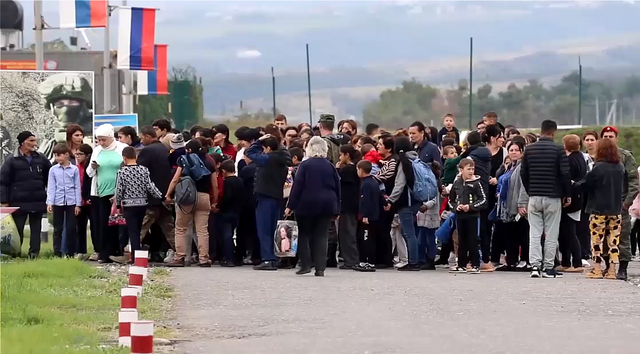Armenia and Azerbaijan both claiming authority over the Nagorno-Karabakh region has resulted in disputes dating back to the 1990s. Formally recognized as an autonomous region of Azerbaijan, Nagorno-Karabakh consists of predominantly ethnic Armenians. The “anti-terrorist” operation by Azerbaijan on September 19 brought an end to the three decade long war with neighboring Armenia in the region. However, it resulted in the displacement of 210,000 ethnic Armenians who became refugees, creating yet another humanitarian crisis.
The collapse of the Soviet Union in 1991 led to the formation of a breakaway state of Nagorno-Karabakh, also known as the Republic of Artsakh. Though it hasn’t received international recognition, it represented the predominant ethnic Armenians in the region. In 1992, the first Nagorno-Karabakh war between Armenians and Azerbaijanis erupted, resulting in around 30,000 civilian deaths and the displacement of 1 million Azerbaijanis. The Armenians occupied the periphery of Nagorno-Karabakh owned by Azerbaijan. The war eventually ceased in May 1995 with the signing of Yeltsin’s Bishkek Protocol. Nevertheless, this intervention failed to ease the regional tension, with another war erupting in 2020.
Since the start of the second war, there has been a noticeable shift in power dynamics. Azerbaijan, with its accumulated wealth from oil production and military advancements since 1992, gained greater power than before. With the support of Turkey and Israel, Azerbaijan managed to reclaim the peripheral areas occupied by Armenia in 44 days. Putin eventually brokered another peace deal, implementing a ceasefire and stationing Russia’s peacekeeping armies on the border of Nagorno-Karabakh. The deal highlighted Russia’s overarching power over the former Soviet Union republics.
Despite the peace deal, the 2020 war renewed tensions in Nagorno-Karabakh. Azerbaijan claimed that Armenia had been occupying a region legally part of their state and put the enclave’s civilians at great risk. In December 2022, Azerbaijan closed the Lachin Corridor, the sole road connecting Armenia and Nagorno-Karabakh, and established military checkpoints. This severely limited the import of necessities such as food, medicine, and fuel. Furthermore, the blockade resulted in a significant humanitarian crisis for the 120,000 ethnic Armenians residing in the Nagorno-Karabakh region. The prolonged restrictions resulted in mass malnutrition and a lack of healthcare services. The United Nations stated that “International humanitarian law is very clear. Parties must allow and facilitate the rapid and unimpeded passage of humanitarian relief for all civilians in need.” Amnesty International also emphasized for the “immediate unblocking of the route and an end to the unfolding humanitarian crisis.” The blockade of the corridor lasted around 9 months. The reopening of this critical pathway, however, did not put an end to the humanitarian crisis. The same road that once transported goods became a packed route as ethnic Armenians fled their homes in Nagorno-Karabakh for Armenia.
The government of Azerbaijan announced that “illegal Armenian military formations must raise the white flag.” Within 24 hours of the anti-terrorist operation, Azerbaijan gained full control of the enclave. The government went on to express its plan to reintegrate the Armenians of Nagorno Karabakh into their land. President Ilham Aliyev mentioned that “People living in the Karabakh region, regardless of their ethnicity, are citizens of Azerbaijan. Their safety, security, and rights will be guaranteed by the Azerbaijani state.” Although Azerbaijan’s claim of authority over its internationally recognized land is valid, the Armenians have the right to demand autonomy and protection against what can now be seen as ethnic cleansing.
Following the blitz, President Samvel Shahramanyan of Artsakh announced the dissolution of the Republic of Artsakh by January 1st, 2024. This resulted in a sudden influx of ethnic Armenians into Armenia, turning them into refugees of their own land. Despite the significant aid coming from the West, Armenia’s ability to accommodate and sustain these refugees remains largely uncertain. Before the exodus of ethnic Armenians, protests in Armenia called for the resignation of the prime minister for failing to protect the ethnic Armenians. The weakened status of the Armenian government, resulting from internal discontent, may pose challenges in incorporating the refugees.
The temporary lift from tensions in Nagorno-Karabakh also shifts focus to the now broader geopolitical relations. The absence of Russia’s intervention may lead to greater instability, as historically, Russia played a major role in mediating conflicts in the southern Caucasus region and protecting the weaker state of Armenia from Azerbaijan. Since the 2020 war, Russia has stayed out of the region. Not only has its focus on Ukraine left little for the allied Armenians, but the 2018 Armenian Velvet Revolution also strained the relationship. The revolution, initiated by the current prime minister Nikol Pashinyan, shifted Armenia’s political dynamics towards government transparency and outward-looking foreign relations, leaving Russia in a vague position. Moreover, the recent decision of the Armenian Parliament to submit the case to join the International Criminal Court (ICC) could further weaken the alliance. If Armenia were accepted to the ICC, it would support the claims of warrants against Vladimir Putin. The Kremlin has responded that Armenia is making the wrong move. Therefore, the once critical role of Russia may deteriorate and along with the internal unrest, the instability of Armenia could impact the status of refugees.
In the past couple of weeks, 100,000 ethnic Armenians have been displaced to Armenia amidst its political unrest. Despite support from humanitarian organizations, it remains to be determined how long and how well Armenia can support these refugees. In addition to responding to this immediate crisis, efforts to guarantee the rights of those who remain in Nagorno-Karabakh will be a crucial step moving forward.
Edited by Isaac Yong
Shihun Lee is a first year student at McGill University, currently pursuing a B.A. degree in Economics and International Development Studies. She joined Catalyst as a staff writer this year and is particularly interested in international relations and human rights.

